
Bill Williams es el creador de algunos de los indicadores del mercado más populares: oscilador asombroso, fractales, alligator y gator.

¡No pierdas tu tiempo – mantente informado para ver cómo las NFP afectan al USD!
Aviso de Recopilación de Datos
Mantenemos un registro de tus datos para ejecutar este sitio web. Al hacer click en el botón, estás aceptando nuestra Política de Privacidad.

Manual para Principiantes de Forex
Tu guía definitiva a través del mundo del trading.
¡Revisa Tu Correo!
En nuestro correo electrónico, encontrarás el Manual de Forex 101. ¡Solo toca el botón para descargarlo!
Advertencia de Riesgo: Los ᏟᖴᎠs son instrumentos complejos y tienen un alto riesgo de pérdida de dinero rápidamente debido al apalancamiento.
El 71,43% de las cuentas de los inversores minoristas pierden dinero al operar ᏟᖴᎠs con este proveedor.
Deberías tener en consideración si comprendes el funcionamiento de los ᏟᖴᎠs y si puedes darte el lujo de arriesgarte a perder tu dinero.
2023-01-17 • Actualizada
Esta información no son consejos para inversión
Un patrón gráfico de triángulo es un patrón de consolidación que implica que el precio de un activo se mueva dentro de un rango que se estrecha gradualmente. Los patrones de triángulos visualizan la batalla entre compradores y vendedores en el mercado. A pesar de esta batalla, los patrones de triángulos generalmente indican la continuación de una tendencia anterior, por lo que los traders tienden a esperar a que el precio salga del rango para ingresar una operación.
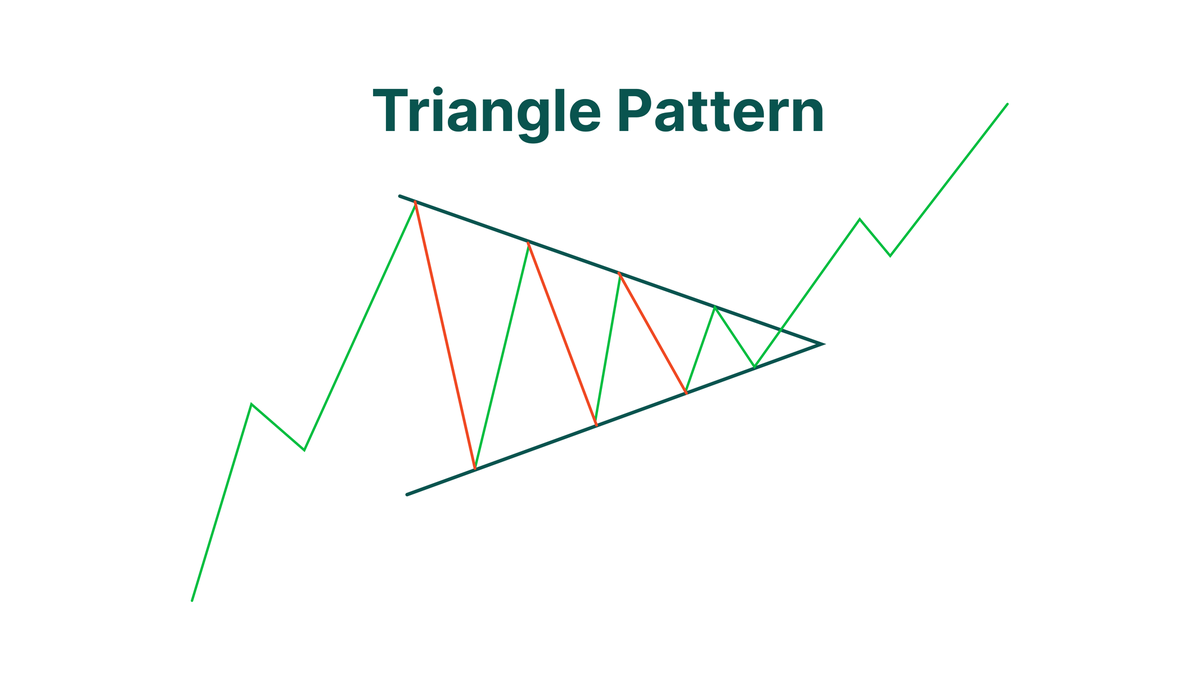
Los patrones de triángulos se pueden identificar en un gráfico trazando dos líneas de tendencia a través de los picos y valles de la formación. Si las líneas de tendencia comienzan muy separadas pero luego convergen, el patrón que observas es de hecho un patrón gráfico de triángulo.
En este artículo, aprenderás sobre los diferentes tipos de patrones de triángulos, cómo identificarlos en un gráfico y qué estrategias de trading puedes emplear si detectas un patrón de triángulo en un gráfico.
El primer tipo de patrón de triángulo que discutiremos es un triángulo simétrico. Echemos un vistazo al gráfico a continuación.
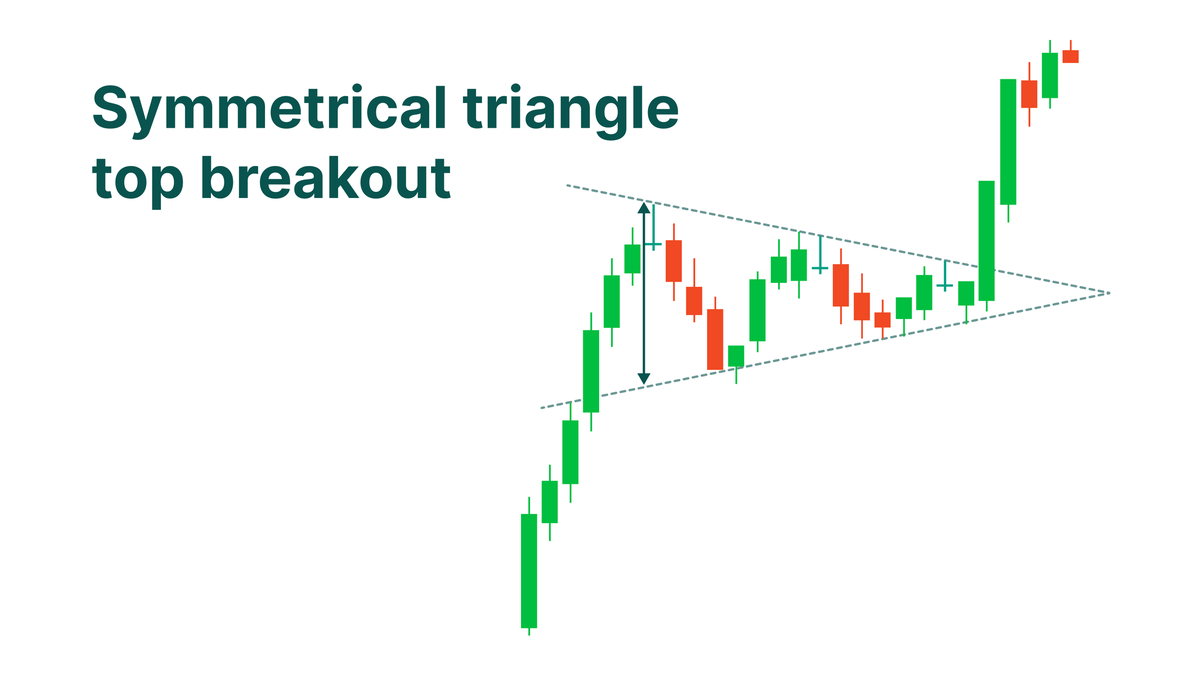
Este es un ejemplo de un típico patrón de triángulo simétrico. Como puedes ver, este patrón se ve muy elegante y apropiado, con ambas líneas de tendencia uniéndose en una pendiente similar. Este patrón se usa a menudo como un ejemplo común de patrones de triángulos porque tiene una forma muy clara y reconocible.
Los triángulos simétricos ocurren cuando el precio comienza a moverse hacia arriba y hacia abajo dentro de un rango limitado que se vuelve cada vez más pequeño con el tiempo. Los picos de los triángulos simétricos se vuelven gradualmente más bajos mientras que los valles siguen moviéndose más arriba que los anteriores.
Los triángulos simétricos generalmente ocurren en mercados que no se mueven en una sola dirección. Ninguna tendencia única domina este mercado, lo que permite que compradores y vendedores influyan por igual en los movimientos de precios y creen un período de consolidación.
Por lo general, cuando el precio sale de este rango limitado de movimiento, se mueve en la dirección de la tendencia anterior con mucho más volumen que durante la formación del patrón, lo que demuestra que los traders se han alejado del período de indecisión y la tendencia está de nuevo en marcha.
El siguiente tipo de patrones de triángulos que vamos a ver es el triángulo ascendente. Los triángulos ascendentes difieren de los triángulos simétricos en que solo su lado inferior está inclinado. El lado superior del triángulo ascendente, trazado a través del pico de la formación, permanece horizontal, lo que indica que la resistencia bajista se mantiene igual a pesar del avance de los toros.
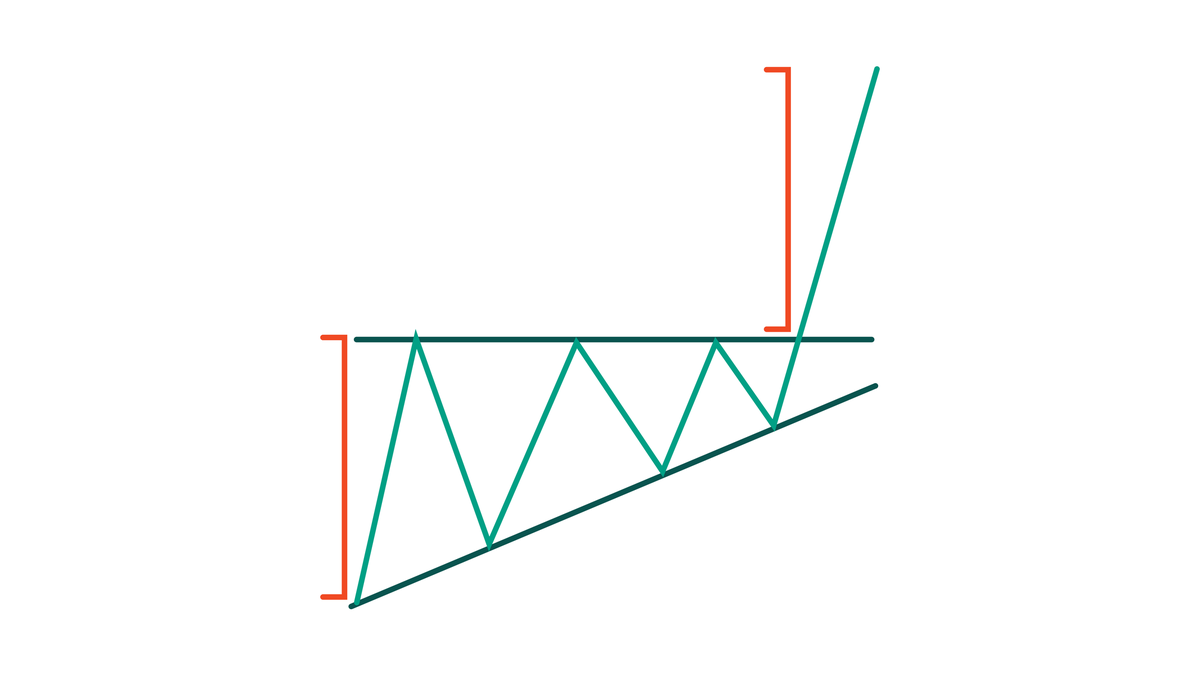
Por lo general, este patrón ocurre después de una tendencia alcista muy clara, que puedes identificar por la naturaleza ascendente de su línea de soporte. Continúa su ascenso y eventualmente converge con la línea de resistencia estática, rompiéndola y reanudando la tendencia alcista anterior. Por lo tanto, el triángulo ascendente se considera un patrón alcista que precede a un aumento en el movimiento de precios y el volumen de trading.
Además de identificar la dirección futura del movimiento de precios, los triángulos ascendentes también pueden indicar el mejor momento para ingresar o salir de operaciones, por lo que detectarlos en el gráfico significa encontrar nuevas oportunidades para operaciones rentables.
El triángulo descendente es todo lo contrario al patrón de triángulo ascendente. Los triángulos descendentes ocurren en un mercado bajista y, como habrás adivinado, se consideran patrones bajistas.
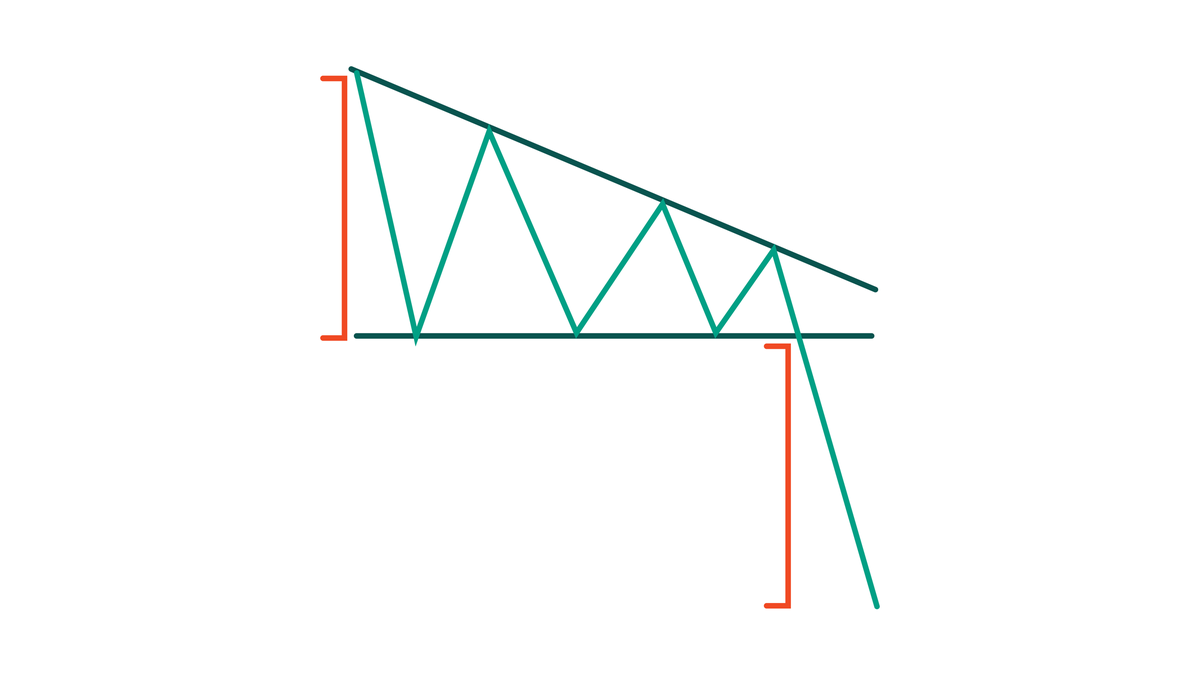
Como puedes ver en este gráfico, el triángulo descendente refleja su contraparte y tiene una línea de tendencia inclinada y otra horizontal. Pero en los triángulos descendentes, el lado inclinado es la línea de resistencia. Este patrón muestra que son los osos los que siguen avanzando sobre los toros, quienes, por su parte, parecen no poder ofrecer el soporte adecuado para contrarrestar la resistencia inminente. Al final, los osos suelen romper la línea de soporte, lo que indica el final y la confirmación del triángulo y la continuación de la tendencia bajista anterior.
Aunque tanto los triángulos descendentes como los ascendentes suelen señalar el comienzo de una tendencia bajista y una tendencia alcista respectivamente, aún es posible que el precio rebote en la línea de tendencia horizontal, lo que da como resultado la reversión de la tendencia anterior. Por lo tanto, la mayoría de las veces es mejor esperar hasta que se complete el patrón antes de tomar cualquier decisión al operar.
Si detectas un patrón de triángulo en tu gráfico, el consejo general es esperar hasta que el precio rompa y forme una nueva tendencia. Cuando esto ocurra, puedes ingresar una operación en el punto del rompimiento y moverte en la dirección en la que se mueva el precio. En cuanto al punto de salida, una vez que se forma un patrón de triángulo, el precio generalmente se mueve aproximadamente la misma distancia que la altura del patrón, por lo que puedes planificar tu próximo movimiento y prepararte para obtener tus ganancias.
Sin embargo, al operar con diferentes formas de triángulos, hay varias cosas a considerar, de las que hablaremos a continuación.
Como ya aprendimos, los triángulos simétricos pueden ocurrir tanto en mercados alcistas como bajistas. Tanto los toros como los osos tienen posiciones equivalentes, por lo que el precio puede terminar moviéndose en cualquier dirección.
Lo que puedes hacer en este caso es colocar órdenes de entrada justo por encima de la línea de la resistencia y por debajo de la línea del soporte. De esta manera, ingresarás automáticamente la operación sin preocuparte por la dirección en la que se moverá el mercado a continuación. O alternativamente, puedes esperar el rompimiento para ver hacia dónde termina moviéndose el precio y luego seguir la corriente.
Veamos el siguiente ejemplo.
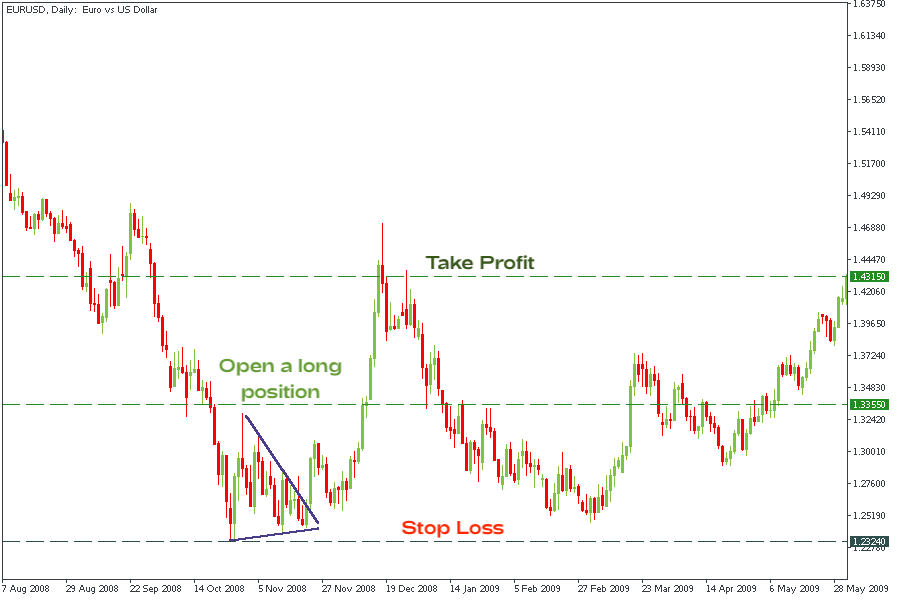
En el gráfico diario del par EURUSD, puedes observar un triángulo simétrico en la intersección de la línea de tendencia ascendente y la línea descendente dentro de una gran tendencia bajista. Después de haber identificado el patrón, esperamos un rompimiento a la baja o al alza. En nuestro ejemplo, la vela rompió la línea de la resistencia y, como resultado, ingresamos la posición en 1,3355. Colocamos un Stop Loss unos 10 puntos por debajo del punto más bajo del triángulo en 1,2324. Como ya mencionamos anteriormente, el movimiento del precio suele ser igual a la altura del patrón. Por eso, como siguiente paso, medimos la distancia entre el punto más alto y el punto más bajo del patrón:
1,3294 - 1,2334 = 0,096.
Habiendo medido eso, ahora podremos determinar la mejor posición para obtener ganancias (1,3355 + 0,096 = 1,4315) y colocar la orden de salida.
Tanto los triángulos ascendentes como los descendentes se producen dentro de tendencias alcistas y bajistas respectivamente y generalmente se consideran patrones de continuación, lo que significa que después del rompimiento el mercado continuará moviéndose en la misma dirección que antes de que ocurriera el patrón.
Sin embargo, este no es siempre el caso. El precio puede rebotar en una de las líneas de tendencia y revertir la tendencia por completo. Teniendo esto en cuenta, es obvio que el curso de acción más seguro al operar con estos patrones es esperar a que se produzca el rompimiento e ir en la siguiente dirección en la que se mueva el precio.
Los siguientes ejemplos ilustran cómo puedes operar con triángulos ascendentes y descendentes.
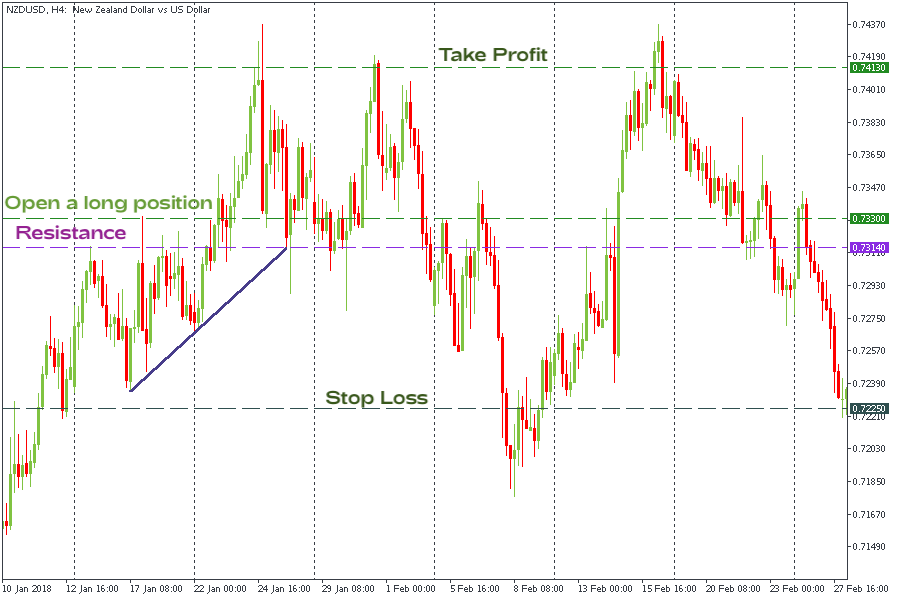
En el gráfico H4 del par NZDUSD, puedes ver un patrón ascendente formado entre una línea de resistencia horizontal en 0,7314 y una línea de soporte inclinada. Decidimos abrir la posición después del rompimiento de la resistencia en 0,7333. Luego, colocamos un Stop Loss en 0,7225 (10 puntos por debajo del punto más bajo del triángulo) y tomamos nuestras ganancias en 0,7413 después de identificar la altura del patrón de triángulo anterior (0,7314 - 0,7234 = 0,08).
Finalmente, veamos cómo operar con un triángulo descendente.

En el gráfico H4, la consolidación en la parte superior de la tendencia alcista muestra que los toros son incapaces de impulsar el precio al alza. Como resultado, se formó un triángulo descendente con la línea del soporte en 0,7470. Decidimos ingresar al mercado en el rompimiento del soporte, por lo que colocamos una orden corta en 0,7455. Para minimizar los riesgos, colocamos un Stop Loss 10 puntos por encima del último pico del triángulo en 0,7534 y colocamos una orden Take Profit en 0,7367.
El patrón de triángulo es uno de los patrones gráficos más comunes y reconocibles que es muy probable que prediga una continuación de la dirección del movimiento del mercado. Sin embargo, los traders deben recordar que siempre existe la posibilidad de que un patrón de triángulo termine revirtiendo la tendencia anterior, por lo que es mejor esperar al rompimiento antes de tomar cualquier decisión.

Bill Williams es el creador de algunos de los indicadores del mercado más populares: oscilador asombroso, fractales, alligator y gator.

Las estrategias de tendencia son buenas: pueden dar resultados significativamente buenos en cualquier temporalidad y con cualquier activo. La idea principal de la estrategia ADX basada en tendencia es intentar posicionarse en el comienzo de la tendencia.

Las estrategias contra tendencia siempre son las más peligrosas, pero también las más rentables. Nos complace presentar una excelente estrategia contra tendencia para trabajar en cualquier mercado y con cualquier activo.
Su solicitud ha sido aceptada
Te llamaremos en el intervalo de tiempo que elijas
La próxima solicitud de devolución de llamada para este número de teléfono estará disponible en 00:30:00
Si tienes algún problema urgente, contáctanos a través del
Chat en vivo
Error interno. Por favor, inténtelo nuevamente más tarde